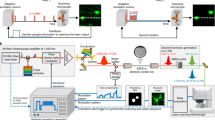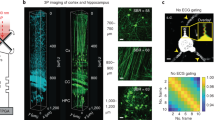Abstract
Although the nonlinear optical effect known as second-harmonic generation (SHG) has been recognized since the earliest days of laser physics and was demonstrated through a microscope over 25 years ago, only in the past few years has it begun to emerge as a viable microscope imaging contrast mechanism for visualization of cell and tissue structure and function. Only small modifications are required to equip a standard laser-scanning two-photon microscope for second-harmonic imaging microscopy (SHIM). Recent studies of the three-dimensional in vivo structures of well-ordered protein assemblies, such as collagen, microtubules and muscle myosin, are beginning to establish SHIM as a nondestructive imaging modality that holds promise for both basic research and clinical pathology. Thus far the best signals have been obtained in a transmitted light geometry that precludes in vivo measurements on large living animals. This drawback may be addressed through improvements in the collection of SHG signals via an epi-illumination microscope configuration. In addition, SHG signals from certain membrane-bound dyes have been shown to be highly sensitive to membrane potential. Although this indicates that SHIM may become a valuable tool for probing cell physiology, the small signal size would limit the number of photons that could be collected during the course of a fast action potential. Better dyes and optimized microscope optics could ultimately lead to the imaging of neuronal electrical activity with SHIM.
This is a preview of subscription content, access via your institution
Access options
Subscribe to this journal
Receive 12 print issues and online access
$209.00 per year
only $17.42 per issue
Buy this article
- Purchase on Springer Link
- Instant access to full article PDF
Prices may be subject to local taxes which are calculated during checkout



Similar content being viewed by others
References
Freund, I., Deutsch, M. & Sprecher, A. Connective tissue polarity. Optical second harmonic microscopy, crossed-beam summation, and small-angle scattering in rat tail tendon. Biophys. J. 50, 693–712 (1986).
Huang, Y.A., Lewis, A. & Loew, L.M. Nonlinear optical properties of potential sensitive styryl dyes. Biophys. J. 53, 665–670 (1988).
Rasing, T., Huang, J., Lewis, A., Stehlin, T. & Shen, Y.R. In situ determination of induced dipole moments of pure and membrane-bound retinal chromophores. Phys. Rev. A 40, 1684–1687 (1989).
Campagnola, P.J., Wei, M.–d., Lewis, A. & Loew, L.M. High-resolution optical imaging of live cells by second harmonic generation. Biophys. J. 77, 3341–3349 (1999).
Moreaux, L., Sandre, O., Blanchard–Desce, M. & Mertz, J. Membrane imaging by simultaneous second harmonic generation and two-photo microscopy. Optics Lett. 25, 320–322 (2000).
Campagnola, P.J. et al. Three-dimensional high-resolution second harmonic generation imaging of endogenous structural proteins in biological tissues. Biophys. J. 82, 493–508 (2002).
Zoumi, A., Yeh, A. & Tromberg, B.J. Imaging cells and extracellular matrix in vivo by using second harmonic generation and two-photon excited fluorescence. Proc. Natl. Acad. Sci. USA 99, 11014–11019 (2002).
Yeh, A.T., Nassif, N., Zoumi, A. & Tromberg, B.J. Selective corneal imaging using combined second harmonic generation and two-photon excited fluorescence. Optics Lett. 27, 2082–2084 (2002).
Zipfel, W.R. et al. Live tissue intrinsic emission microscopy using multiphoton–excited native fluorescence and second harmonic generation. Proc. Natl. Acad. Sci. USA 100, 7075–7080 (2003).
Dombeck, D.A. et al. Uniform polarity microtubule assemblies imaged in native brain tissue by second harmonic generation microscopy. Proc. Natl. Acad. Sci. USA 100, 7081–7086 (2003).
Brown, E. et al. Dynamic imaging of collagen and its modulation in tumors in vivo using second harmonic generation. Nat. Med. 9, 796–800 (2003).
Hellwarth, R. & Christensen, P. Nonlinear optical microscopic examination of structure in polycrystalline ZnSe. Optics Comm. 12, 318–322 (1974).
Sheppard, C.J.R., Kompfner, R., Gannaway, J. & Walsh, D. Scanning harmonic optical microscope. IEEE J. Quantum Electron. 13E, 100D (1977).
Bouevitch, O., Lewis, A., Pinevsky, I., Wuskell, J.P. & Loew, L.M. Probing membrane potential with non-linear optics. Biophys. J. 65, 672–679 (1993).
Ben-Oren, I., Peleg, G., Lewis, A., Minke, B. & Loew, L.M. Infrared nonlinear optical measurements of membrane potential in photoreceptor cells. Biophys. J. 71, 1616–1620 (1996).
Moreaux, L., Sandre, O. & Mertz, J. Membrane imaging by second harmonic generation microscopy. J. Opt. Soc. Am. B 17, 1685–1694 (2000).
Mohler, W., Millard, A.C. & Campagnola, P.J. Second harmonic generation imaging of endogenous structural proteins. Methods 29, 97–109 (2003).
Stoller, P., Reiser, K.M., Celliers, P.M. & Rubenchik, A.M. Polarization-modulated second harmonic generation in collagen. Biophys. J. 82, 3330–3342 (2002).
Stoller, P., Kim, B.M., Rubenchik, A.M., Reiser, K.M. & Da Silva, L.B. Polarization-dependent optical second harmonic imaging of a rat-tail tendon. J. Biomed. Opt. 7, 205–214 (2002).
Campagnola, P.J., Clark, H.A., Mohler, W.A., Lewis, A. & Loew, L.M. Second harmonic imaging microscopy of living cells. J. Biomed. Opt. 6, 277–286 (2001).
Millard, A.C., Campagnola, P.J., Mohler, W., Lewis, A. & Loew, L.M. Second harmonic imaging microscopy. Methods Enzymol. 361, 47–69 (2003).
Cox, G. et al. 3-dimensional imaging of collagen using second harmonic generation. J. Struct. Biol. 141, 53–62 (2003).
Inoue, S. Video Microscopy (Plenum Press, New York, 1986).
Brown, E. et al. Dynamic imaging of collagen and its modulation in tumors in vivo using second harmonic generation. Nat. Med. 9, 796–800 (2003).
Loew, L.M. in Fluorescent and Luminescent Probes for Biological Activity (ed. Mason, W.T.) 210–221 (Academic Press, London, 1999).
Huang, J.Y., Lewis, A. & Loew, L.M. Non-linear optical properties of potential sensitive styryl dyes. Biophys. J. 53, 665–670 (1988).
Clark, H.A., Campagnola, P.J., Wuskell, J.P., Lewis, A. & Loew, L.M. Second harmonic generation properties of fluorescent polymer encapsulated gold nanoparticles. J. Am. Chem. Soc. 122, 10234–10235 (2000).
Moreaux, L., Sandre, O., Charpak, S., Blanchard–Desce, M. & Mertz, J. Coherent scattering in multi-harmonic light microscopy. Biophys. J. 80, 1568–1574 (2001).
Millard, A.C., Jin, L., Lewis, A. & Loew, L.M. Direct measurement of the voltage sensitivity of second harmonic generation from a membrane dye in patch-clamped cells. Optics Lett. 28, 1221–1223 (2003).
Moreaux, L., Pons, T., Dambrin, V., Blanchard–Desce, M. & Mertz, J. Electro–optic response of second harmonic generation membrane potential sensors. Optics Lett. 28, 625–627 (2003).
Peleg, G. et al. Gigantic optical non-linearities from nanoparticle enhanced molecular probes with potential for selectively imaging the structure and physiology of nanometric regions in cellular systems. Bioimaging 4, 215–224 (1996).
Peleg, G., Lewis, A., Linial, M. & Loew, L.M. Nonlinear optical measurement of membrane potential around single molecules at selected cellular sites. Proc. Natl. Acad. Sci. USA 96, 6700–6704 (1999).
Acknowledgements
The authors would like to thank their collaborators Aaron Lewis, Andrew Millard, William Mohler, Heather Clark and David Boudreau for their contributions to this work. We gratefully acknowledge financial support under US Office of Naval Research grant no. N0014-98-1-0703, National Institute of Biomedical Imaging and Bioengineering grant no. R01EB00196 and National Center for Research Resources grant no. R21 RR13472.
Author information
Authors and Affiliations
Corresponding author
Ethics declarations
Competing interests
The authors declare no competing financial interests.
Rights and permissions
About this article
Cite this article
Campagnola, P., Loew, L. Second-harmonic imaging microscopy for visualizing biomolecular arrays in cells, tissues and organisms. Nat Biotechnol 21, 1356–1360 (2003). https://doi.org/10.1038/nbt894
Published:
Issue Date:
DOI: https://doi.org/10.1038/nbt894
This article is cited by
-
Label-free quantification of imaging features in the extracellular matrix of left and right-sided colon cancer tissues
Scientific Reports (2024)
-
Prognostic value of tumor necrosis based on the evaluation of frequency in invasive breast cancer
BMC Cancer (2023)
-
Label-free, multi-parametric assessments of cell metabolism and matrix remodeling within human and early-stage murine osteoarthritic articular cartilage
Communications Biology (2023)
-
Second harmonic generation microscopy: a powerful tool for bio-imaging
Biophysical Reviews (2023)
-
Arthritis-associated osteoclastogenic macrophage, AtoM, as a key player in pathological bone erosion
Inflammation and Regeneration (2022)



